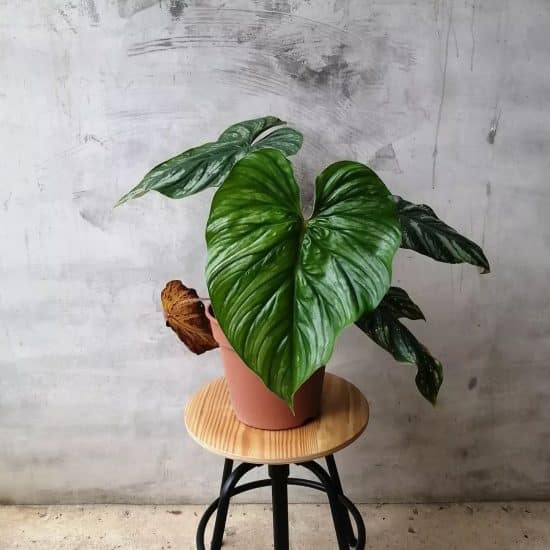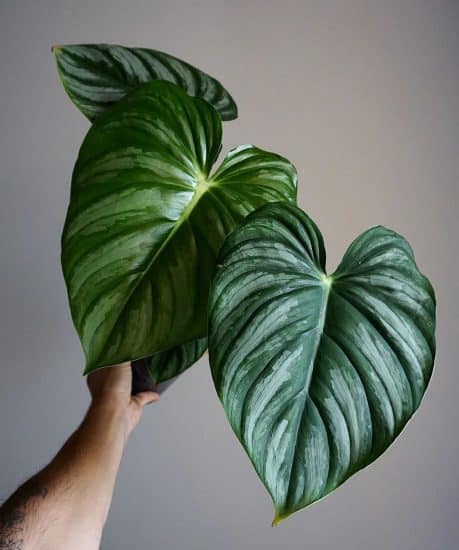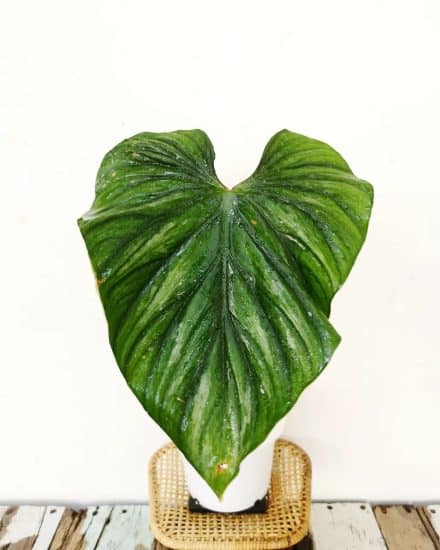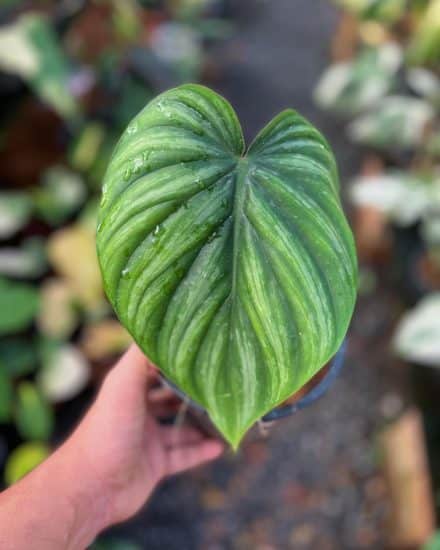Meet the relatively new Philodendron plowmanii, a slow-growing tropical plant sure to become a conversation starter among your indoor plant collection.
It’s so new that as of this writing, it hasn’t even been officially published in the plant literature yet!
With eye-catching large quilted leaves and striking red roots, this low-maintenance houseplant brings a touch of tropical elegance to your home.
In this comprehensive guide, we’ll dive deep into all aspects of Philodendron plowmanii care, from providing the perfect amount of light to mastering humidity and temperature requirements.
Plus, we’ll delve into Philodendron plowmanii propagation and tackle common issues like diseases and pests.
Let’s get growing!
Table of Contents
Philodendron Plowmanii plant care
History, habitat, and characteristics

Philodendron plowmanii is a slow-growing stunner hailing from Peru and Ecuador’s verdant cloud forests.
What sets Philodendron plowmanii apart? It’s all in the details, like the gradients of yellow and green on its large heart-shaped leaves, subtly pink-hued petioles, and those mesmerizing red roots. Also, its leaves are quilted and have ruffled petioles, which is unusual for a philodendron.
We should note here that its juvenile form is different than its mature: younger leaves are smoother and have uniform silver markings that disappear as the plant ages.
Fun fact: Philodendron plowmanii is named after Dr. Timothy Plowman, a distinguished ethnobotanist and plant enthusiast. His extensive research on the Philodendron genus led to this delightful species being named in his honor.

And there’s more to adore about this plant. It has a crawling habit, bringing a dynamic touch to any room it’s in. In the botanical world, this type of growth is known as repent.
Philodendron plowmanii’s stem is actually the base of the entire plant, not just leaf support, as it might appear. Instead, petioles (stalks that connect leaves to stems) support the leaves. Both petioles and roots grow from the nodes (little bumps) along the stem, which are close together.
Just a heads up: the Philodendron plowmanii may grow slowly, but with some care, it can get quite large — 30 feet tall outside and up to eight feet high inside. Its massive leaves alone grow anywhere from 7-15 inches, so be sure to give this plant ample room to flourish and truly make an impact!
Is it a Philodendron plowmanii?

Certain plants in the philodendron species resemble P. plowmanii, but if you look closely, they have clear identifying characteristics that set them apart.
Philodendron plowmanii vs. Philodendron mamei – Leaves are shaped similarly, but P. mamei is a bit smaller and pointier at the tip, and sports silver variegation that the adult form of P. plowmanii doesn’t have. Note that both types can have ruffled petioles depending on the form, so this isn’t necessarily a good way to identify them.
Philodendron plowmanii vs. Philodendron pastazanum – This one is tricky. Both plants have those large green-shaded, heart-shaped leaves, but P. pastazanum’s leaves are lighter and have white veins. P. plowmanii doesn’t have any white and has darker green leaves.
Philodendron plowmanii variegated
I’ve heard rumors of a more heavily variegated Philodendron plowmaniis, but nothing is known to be stable or documented in the literature (unsurprising, since P. plowmanii itself isn’t officially described yet). If you spot one, let us know!

There is, however, a ‘Round Form,’ which is slightly harder to come by.
Light

In its natural habitat, this tropical plant creeps along in rainforest understories, basking in dappled sunlight that filters through the canopy.
To recreate this cozy environment at home, aim to provide your Philodendron plowmanii with moderate to bright indirect light.
If your Philodendron plowmanii is getting too little light, you might notice slow or leggy growth, with the plant practically reaching out for a light source (this is called etiolating). The leaves could also lose their vibrancy and turn darker.
What can you do? Simply move your plant closer to a window with bright, indirect light or grab a full-spectrum LED grow light to give it a boost.
But what if your plant is getting too much light? Direct sunlight can stress out your beloved Philodendron plowmanii. You might see signs of sunburn, like yellowing, browning, or crispy leaf edges (ouch!).
To fix this, just reposition your plant somewhere with ample indirect light, like bright light that’s shielded from those strong sunrays. A sheer curtain over the window can work wonders, too.
Water

Striking the right watering balance for your Philodendron plowmanii is just that: a balance. This plant loves slightly moist soil, but you’ve got to make sure it’s well-drained.
If you’re looking to get into using LECA (Lightweight Expanded Clay Aggregate), this plant is a great candidate for a self-watering system that will make your plant happy while making your life easier.
(You can read more in our full LECA guide.)
Otherwise, how can you tell if it’s the right time to water? Just poke your finger about an inch into the soil . . . If it feels dry, go ahead and give it a good soak. If it’s still moist, hold your horses and check again in a day or two.
Philodendron plowmanii watering tips:
- When you water your plant, drench the soil evenly – and don’t forget to let the excess water drain away through those bottom holes to avoid waterlogging the roots.
- Not enough water might make the leaves wilt, curl, or even turn yellow (especially those older, bottom leaves). Catching these red flags? Time to up your watering game, my friend! Oh, and be sure to remove any damaged leaves – they’re magnets for pesky pests.
- Too much water could cause old and new yellowing leaves, mushy stems, and constantly damp soil. Let the soil dry out before watering again, and consider dialing back the watering frequency.
- Tap water will work, but try to use distilled, filtered, or rainwater if you can to prevent chemical buildup in the soil, especially if you notice yellow or brown leaf edges with no other cause.
Temperature and humidity

Philodendron plowmanii thrives in an indoor environment similar to its native tropical habitat.
As a tropical plant, Philodendron plowmanii enjoys standard to slightly higher indoor temperatures. Aim to keep the room temp between 65-80 degrees Fahrenheit.
Be mindful of any drafts or sudden drops in temperature, as these can shock your plant. Avoid drafty windows and air conditioners that might cause potential temperature fluctuations. Symptoms of cold shock when temps are too low include wilted or blackened leaves, and slowed growth.
If your plant’s leaves are drooping, turning yellow, or appearing scorched, the room temperature may be too high. Move your Philodendron plowmanii to a cooler spot or adjust the room temperature accordingly.

Philodendron plowmanii loves high humidity (remember: tropical plants)! To keep your plant happy and healthy, aim for a humidity level of 60% or higher.
If there’s not enough humidity in your plant’s environment, you’ll see withered, curling leaves, or leaves with brown tips. If, like mine, your house doesn’t achieve a lot of humidity naturally, there are ways you can increase it.
To raise humidity:
- Place your plant on a pebble tray filled with water, which increases the immediate humidity around it.
- Group it with other humidity-loving plants to create a more humid microclimate.
- Add a cool-mist humidifier nearby to increase the humidity level right by your plant. Just make sure to use distilled water and keep that reservoir clean.
Soil and planting

Philodendron plowmanii requires moist soil that’s rich in organic matter and nutrients. You’ll want a potting mix similar to:
- 60% potting soil
- 30% perlite
- 10% coco coir (an environmentally-friendly alternative to sphagnum moss)
Together, these ingredients balance moisture retention and draining. You can also mix regular potting soil 50/50 with a succulent soil and get a pretty nice substrate.
If your soil mix is off, you may see wilting or yellowing leaves, while root rot can develop if the potting mix retains too much water.
Pruning Philodendron plowmanii
Your Philodendron plowmanii shouldn’t need much pruning other than to snip off dead or dying leaves. Use sterilized scissors or shears and try to prune in the springtime when the plant will be healthiest.
Repotting Philodendron plowmanii

Philodendron plowmanii doesn’t need to be repotted often, every 2-3 years or so. When you do repot, spring is the best time as the plant is actively growing then and will be less stressed.
Pick a pot only one or two inches larger than its current one, with at least one or two drainage holes. Terracotta pots are ideal for this plant, since they’re porous and let the soil dry out more quickly, preventing rotting roots.
When repotting Philodendron plowmanii, be gentle with the root system and avoid packing the soil too tightly around the root ball so the roots can get enough oxygen.
Fertilizing Philodendron plowmanii
Opt for a balanced liquid houseplant fertilizer diluted to half strength, and apply it monthly during the growing season (spring and summer). Avoid fertilizing your Plowmanii during the winter months when it’s dormant.
Over-fertilizing your Philodendron plowmanii can lead to leaf burn, discoloration, and weak growth. If you notice the edges of your plant’s leaves turning brown or yellow, it could be an indication that you’re using too much fertilizer.
To resolve this issue, flush the soil with water to remove excess fertilizer salts, and cut back on your fertilizing schedule or amount.
Propagation Guide for Philodendron Plowmanii

Let’s talk about how to propagate your Philodendron plowmanii and fill your home with even more gradient green.
We’ll guide you through stem cutting propagation in both water and soil. (You can also use LECA instead).
Propagating Philodendron plowmanii with stem cuttings in water or soil:
- Pick a healthy stem. A clean, sterilized pair of gardening shears will do the trick for a clean cut between the leaf nodes. Make sure your cutting has at least two healthy leaves – they love company!
- Give the bottom node some breathing room by removing any lower leaves. This keeps those leaves from decaying and making a mess.
- Pop the cutting into a small container filled with water or soil. The node should be submerged or buried, but the leaves should remain above the surface. For water, filtered or rainwater is preferred, as tap water might have chemicals that can ruin the party for your cutting.
- Put the container in a spot with bright, indirect sunlight. For water, keep things fresh by changing the water every 2-3 days. For soil, keep it consistently moist but not sopping. Don’t worry if it takes a few weeks for new roots to develop – good things come to those who wait!
- Once you see a well-established root system, it’s time for your stem cuttings to move into their new home: a container of our suggested soil mix above.

And that’s it — really! Share the knowledge and help get more of these guys out into the world.
Common issues

Does your Philodendron plowmanii have yellow leaves or brown leaf tips? Not to worry; we’ll explain why this happens and how to get your plant back on track in no time.
Yellow leaves

Yellow leaves are often a sign of stress, usually caused by overwatering, insufficient watering, or lack of filtered light. First, check the moisture level of the soil. If it’s wet and soggy, let the soil dry out a bit before watering again. If it’s bone dry, give your plant a drink.
(And hey, having proper drainage is key, so make sure your plant pot has those much-needed drainage holes!)
If your Philodendron plowmanii is in bright direct light, move it a few feet back from the window or use a sheer curtain to filter. If you can, find a cozy spot with bright, indirect light for it to call home.
Browning leaf tips
Pesky brown tips . . . on my perfect plowmanii leaves?! It could be due to a lack of humidity, improper watering, or even some uninvited pests.
To crack the case, check that the humidity in your plant’s environment is as close to 60% or higher as possible. If it’s low, follow the tips in our “Temperature and humidity” section above. Water when the top few inches of soil is dry, and make sure the soil/pot you’re using drains well.
Finally, take a good look at your plant and check for any signs of bugs. If you find any, check out the “Pests and diseases” section below.
Slow Growth
Is your Philodendron plowmanii a slow grower? (That was a trick question — they all are!) But if it seems to be growing a bit too slowly, it might be due to low light conditions or stress from those sneaky pests we mentioned earlier.
To ensure your plant grows optimally, make sure it’s living its best life in a spot with plenty of bright, indirect light and enough water. Double-check for pests and handle them accordingly (see below).
If you haven’t been fertilizing, consider giving your plant a balanced liquid fertilizer once a month during the growing season to up its nutrient quotient. With a little TLC and attention, your Philodendron plowmanii will be flourishing in no time!
Pests and diseases

Philodendron plowmanii diseases are the same as other philodendron plants. This plant can also sometimes have a few unwanted visitors — the usual suspects. We’ll help you identify and handle these problems so your plant can flourish.
Root rot
Root rot is a sneaky problem usually caused by overwatering or poor soil drainage. You’ll know it’s happening when you see yellow lesions on leaves, get a whiff of a rotting smell, and notice black or brown, slimy roots. Yuck.
Solution: To fix root rot, carefully take your plant out of its pot and snip away any affected roots using sterilized scissors. Repot your plant baby in fresh, well-draining soil with plenty of perlite, pumice, or LECA to get that air and drainage flowing.
Hold off on watering until the top couple inches of soil are dry to the touch. Your Plowmanii will thank you.
To keep root rot at bay in the future, only water when the soil is dry an inch or so down, and make sure the pot has proper drainage holes.
Pests
Mealybugs, aphids, scale, and even ants can be issues for P. plowmanii. Ants are often found farming mealybugs for their honeydew . . . so if you see them, mealybugs could be partying nearby as well.
Mealybugs are those tiny white cotton-like critters hanging out on stems and the undersides of leaves. These pests may have been attracted to your plant due to the calcium oxalate crystals it produces (which are why it’s toxic to pets and humans, by the way).
Solution: To shoo those pesky bugs away, gently spray off any visible mealybugs and ants (a little tap water should do the trick). Mix up a solution of dish soap and water, or grab some diluted neem oil, and slather it on the affected plant areas, making sure to get the undersides of leaves.
If things are looking pretty serious, opt for an insecticidal soap or spray. Don’t forget to follow the directions on the label.
To steer clear of future infestations, give your plant regular check-ups, and keep it clean by wiping its leaves with a damp cloth. If ants were the issue, try ant traps or natural repellents near your plant’s spot.
Conclusion

Philodendron plowmanii may be a slow grower, but she’s worth it. And who knows, maybe you’ll come across an elusive variegated variety one day . . . or discover your own.
We hope this guide has been helpful in your journey to becoming a Philodendron plowmanii plant parent! Share it with friends, and don’t hesitate to reach out on Twitter or Facebook if you have any questions or concerns.
Take care, and happy plant parenting!
FAQ
Is Philodendron plowmanii a climber or crawler?
Philodendron plowmanii is a crawler, not a climber. In its natural habitat, it creeps along the forest floor. Botanists call this type of stem growth “repent.” (Okay, I’m sorry, I’m sorry!).
Is Philodendron plowmanii rare?
It’s currently pretty rare, yes. Its striking quilted and green/yellow gradient leaves paired with red roots make it a hot item that isn’t in ready supply.
Is Philodendron plowmanii easy to care for?
Yup! Philodendron plowmanii is a low-maintenance plant that thrives in moderate to bright indirect light, slightly moist soil, normal to higher household temps, and high humidity.
Is Plowmanii a fast grower?
Philodendron plowmanii is generally considered a slow-growing plant, but with the right conditions and care, it can still reach a considerable size over time — up to 8 feet tall inside!


